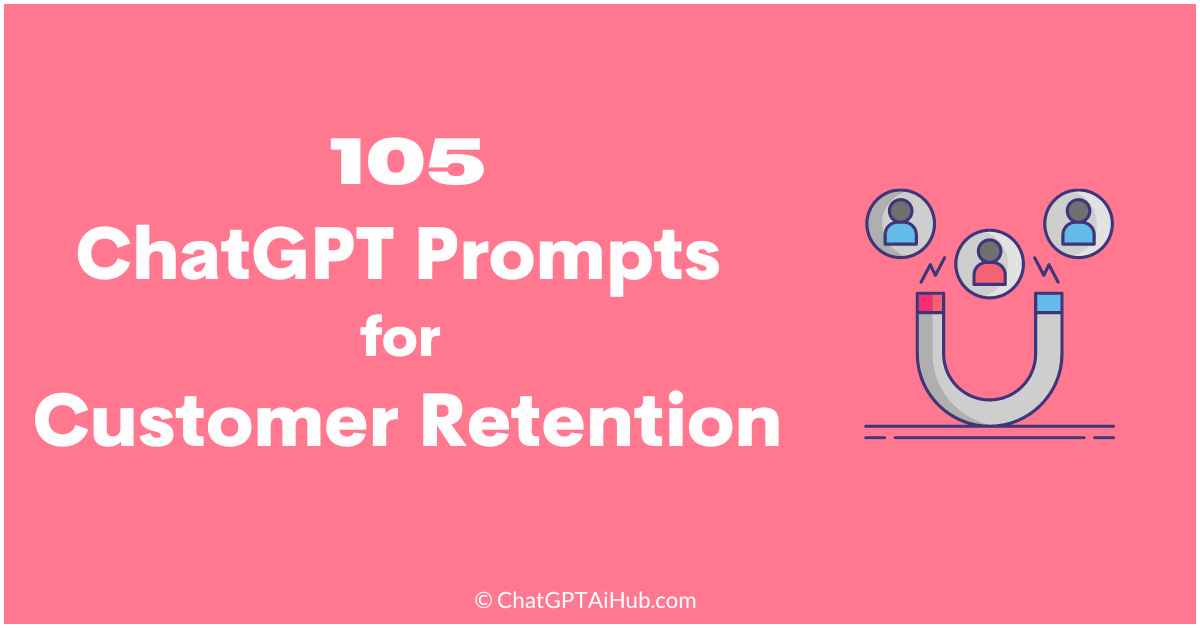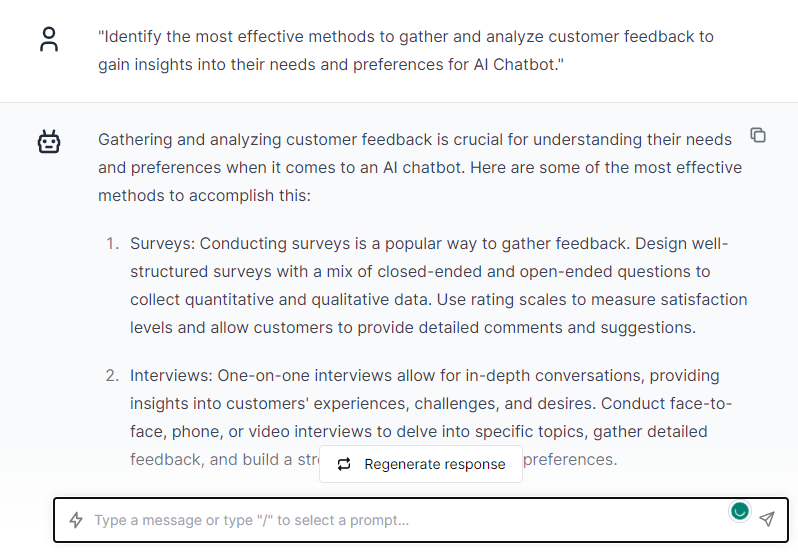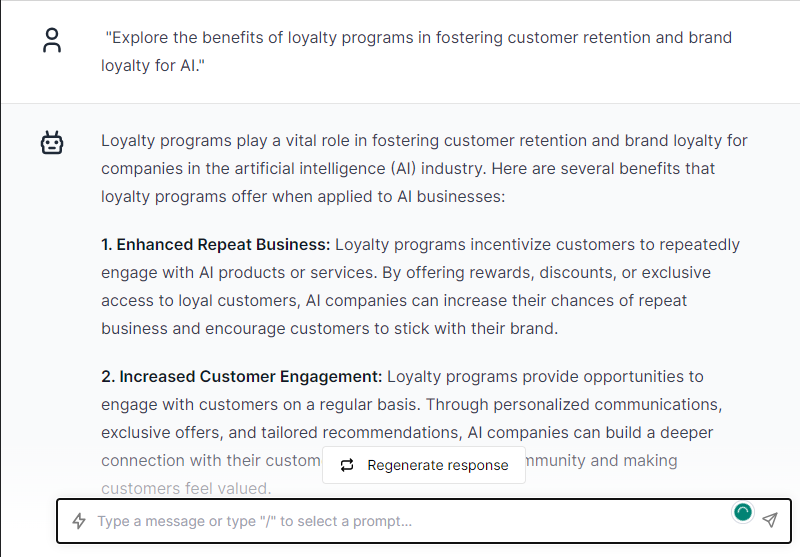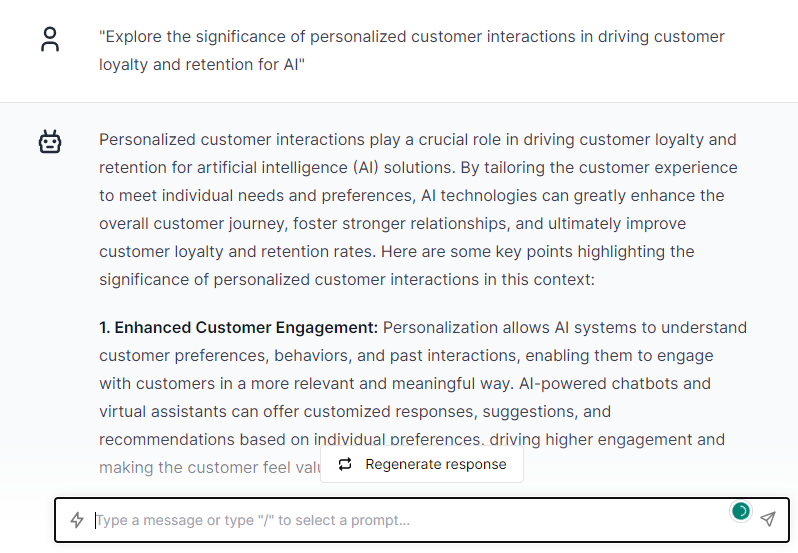105 Useful ChatGPT Prompts for Customer Retention – Maximize Customer Loyalty

Are you looking for effective ways to retain your customers through the assistance of ChatGPT? In this article, we have a comprehensive list of the best ChatGPT prompts for customer retention. These prompts consist of specific words and sentences that, when provided to ChatGPT, yield precisely the results you desire. Whether you want to enhance customer engagement, resolve queries, or offer personalized recommendations, ChatGPT has got you covered. Join us as we explore the power of ChatGPT prompts for customer retention and unlock the potential of this remarkable AI tool.
Challenge of Customer Retention
Keeping customers engaged and retaining their loyalty is a common challenge faced by businesses. Without effective strategies in place, customers may lose interest, seek alternatives, or become dissatisfied. ChatGPT prompts for customer retention provide a solution to this problem by enabling businesses to tailor interactions, address concerns, and meet customers’ specific needs, ultimately fostering a stronger and lasting relationship. Let’s explore some of the best ChatGPT prompts that can help businesses overcome the challenge of customer retention.
Discover the Power of ChatGPT Prompts
By leveraging the carefully curated list of ChatGPT prompts for customer retention, readers can enhance their customer support strategies, boost engagement, and drive customer satisfaction. Through the implementation of these prompts, businesses can expect increased customer retention rates, improved customer interactions, and a strengthened brand image. Get ready to discover the transformative potential of ChatGPT prompts as we delve into the best practices for utilizing them effectively in customer retention strategies.
Why are ChatGPT Prompts for Customer Retention Crucial?
ChatGPT prompts for customer retention are essential tools that hold immense value for both businesses and individuals alike. For businesses, these prompts offer the potential to significantly impact their profits, efficiency, and customer satisfaction metrics. According to a recent study by Forbes, 70% of companies that prioritize customer retention report higher revenues compared to those that do not. This translates to a direct positive impact on the bottom line, creating a strong incentive for businesses to invest in customer retention strategies.
Benefits of Customer Retention:
1. Increased Revenue: Repeat customers are more likely to make additional purchases over time, leading to a steady and reliable revenue stream. They are familiar with your products or services, making the sales process more efficient and cost-effective.
2. Higher Customer Lifetime Value (CLV): Loyal customers tend to have a higher CLV as they continue to buy from your business over an extended period. By retaining customers, you can maximize the value they bring to your company.
3. Cost Savings: Acquiring new customers typically involves higher marketing and advertising costs. In contrast, retaining existing customers is generally more cost-effective, saving your business valuable resources.
4. Word-of-Mouth Marketing: Satisfied customers are more likely to recommend your business to their friends, family, and colleagues. Positive word-of-mouth can significantly enhance your brand reputation and attract new customers through referrals.
5. Enhanced Brand Loyalty: Loyal customers have a strong emotional connection to your brand, which can create a competitive advantage. They are less likely to be swayed by your competitors and may even resist switching to other brands or products.
6. Reduced Churn: Customer churn refers to the rate at which customers stop doing business with your company. By implementing effective customer retention strategies, you can decrease churn and stabilize your customer base.
7. Improved Customer Engagement: Engaged customers are more likely to provide valuable feedback, participate in surveys, and offer insights that can help you improve your products or services.
8. Upselling and Cross-Selling Opportunities: Satisfied customers are more receptive to upselling and cross-selling efforts. By offering relevant additional products or services, you can increase your average order value.
9. Long-Term Business Sustainability: Prioritizing customer retention signals that your business is committed to delivering value and excellent service. This commitment can contribute to the long-term sustainability and success of your company.
10. Competitive Advantage: Companies with high customer retention rates often have a competitive edge. Building strong relationships with your customers can be a unique selling point that sets your business apart from competitors.
11. Feedback for Improvement: Loyal customers are more likely to provide constructive feedback. Understanding their needs and concerns can help you make necessary improvements to your offerings and overall customer experience.
12. Customer Advocacy and Support: Loyal customers can become brand advocates, actively promoting your products or services and defending your brand against criticism.
ChatGPT Prompts for Customer Retention – Boost Business Success

1. “Explore effective customer retention strategies across industries, including personalized interactions, loyalty programs, and proactive complaint resolution, to identify the most impactful approaches for your [business/website].”
2. “Discuss the role of exceptional customer service in fostering long-term relationships and customer loyalty, and outline strategies to ensure consistent, high-quality interactions to maximize customer retention.”
3. “Analyze the importance of understanding customer needs, preferences, and pain points in tailoring your products/services, pricing, and marketing efforts for enhanced customer retention and increased lifetime value.”
4. “Examine the significance of ongoing engagement and communication with customers through targeted content, exclusive offers, and follow-up interactions, and how these efforts contribute to improved customer retention rates.”
5. “Develop a comprehensive customer retention plan, incorporating retention metrics, customer feedback loops, and retention-focused KPIs, to systematically measure and improve customer loyalty and retention for your [business/website].”
1. Identify the Target Customers
1. Develop personalized retention strategies for our existing [loyal customers] to enhance their loyalty and encourage repeat purchases.

2. Identify and analyze the specific needs and preferences of our [new customers] to implement targeted retention campaigns and nurture their long-term loyalty.
3. Create a customer segmentation strategy to categorize our audience into [high-value customers], [low-engagement customers], and more, enabling tailored retention efforts for each group.
4. Implement customer feedback surveys to gather insights from our [frequent purchasers], allowing us to address their concerns and improve their overall experience.
5. Utilize data analytics to identify key characteristics and behaviors of our [churned customers], enabling proactive measures to win them back and reduce the churn rate.
6. Conduct in-depth market research to understand the pain points and expectations of our [potential customers], guiding us in crafting compelling retention offers for them.
7. Develop a referral program to incentivize our [satisfied customers] to refer friends and family, creating a network of loyal customers and driving word-of-mouth growth.
8. Leverage social media analytics to identify our most influential [brand advocates], fostering stronger relationships and utilizing their advocacy to enhance customer retention.
9. Implement targeted email marketing campaigns for our [inactive customers], re-engaging them with personalized offers and promotions to encourage repeat purchases.
10. Use customer lifetime value analysis to prioritize retention efforts on our [high-potential customers], maximizing their long-term value to the business.
2. Understand Customer Needs and Preferences.
1. “Identify the most effective methods to gather and analyze customer feedback to gain insights into their needs and preferences for [your product or service].”

2. “Explore the significance of conducting customer surveys and interviews to understand their evolving expectations and improve retention rates for [your target audience].”
3. “Learn how to create customer personas to better comprehend individual preferences and tailor retention strategies accordingly for [your specific customer segments].”
4. “Investigate the role of data analytics in understanding customer behavior and using the data to enhance their overall experience with [your brand].”
5. “Discover the impact of personalized recommendations and product suggestions on customer retention and loyalty for [your customer base].”
6. “Explore the benefits of monitoring customer interactions and touchpoints to gain valuable insights into their preferences and pain points in relation to [your products or services].”
7. “Examine the use of customer satisfaction metrics like NPS (Net Promoter Score) to gauge customer loyalty and retention potential for [your business].”
8. “Understand the importance of delivering exceptional customer service that aligns with their specific needs and preferences for [your target market].”
9. “Learn how to leverage social listening and online reviews to understand customer sentiment and address concerns promptly for [your brand].”
10. “Explore the significance of loyalty programs and incentives in keeping customers engaged and committed to your brand for [your loyal customer base].”
3. Provide Excellent Customer Service
1. “Explore the key elements of excellent customer service and how they contribute to enhancing customer retention for [your business/website].”

2. “Discuss the impact of responsive customer support and its role in fostering loyalty and trust among customers for [your product/service].”
3. “Learn effective strategies for handling customer complaints and resolving issues promptly to ensure high customer satisfaction and retention for [your business/website].”
4. “Investigate the benefits of personalized customer interactions and how they create a positive impression, leading to increased customer retention for [your product/service].”
5. “Examine the significance of training customer service representatives to deliver exceptional experiences and build lasting relationships with customers for [your business/website].”
6. “Discover the role of self-service tools and resources in empowering customers to find solutions independently, contributing to improved retention rates for [your product/service].”
7. “Understand the impact of proactive customer engagement and follow-ups in ensuring customer loyalty and repeat business for [your business/website].”
8. “Explore the benefits of incorporating customer feedback into your service improvement processes to continuously enhance the customer experience and retain loyal customers for [your product/service].”
9. “Discuss the use of customer service metrics, such as CSAT (Customer Satisfaction Score) and CES (Customer Effort Score), in measuring service quality and its influence on customer retention for [your business/website].”
10. “Learn how to leverage technology, such as chatbots and AI-powered support, to provide real-time assistance and optimize customer service for [your product/service].”
4. Implement Loyalty Programs
1. “Explore the benefits of loyalty programs in fostering customer retention and brand loyalty for [your business/website].”

2. “Discuss the key elements of an effective loyalty program and how it incentivizes customers to remain loyal to [your product/service].”
3. “Learn about different types of loyalty programs, such as points-based systems, tiered rewards, and exclusive offers, and their impact on customer retention for [your business/website].”
4. “Examine successful case studies of businesses that have implemented loyalty programs and their resulting impact on customer retention and long-term revenue growth.”
5. “Develop a comprehensive loyalty program strategy tailored to your target audience, ensuring it aligns with the needs and preferences of [your customers].”
6. “Understand the role of data analysis in optimizing loyalty programs, leveraging customer insights to tailor rewards and offers for increased customer retention for [your product/service].”
7. “Discuss the importance of communication and marketing in promoting your loyalty program to customers, driving engagement and participation for [your business/website].”
8. “Explore innovative approaches to customer rewards, such as surprise gifts, personalized recommendations, and referral incentives, to boost loyalty and retention for [your product/service].”
9. “Learn how to measure the success of your loyalty program using key performance indicators (KPIs) like customer retention rate, repeat purchase rate, and customer lifetime value.”
10. “Discuss the potential challenges and solutions in implementing a loyalty program, ensuring seamless integration and maximum impact on customer retention for [your business/website].”
5. Personalize Customer Interactions
1. “Explore the significance of personalized customer interactions in driving customer loyalty and retention for [your business/website].”

2. “Discuss the various methods and technologies available to personalize customer interactions, such as personalized emails, product recommendations, and tailored offers.”
3. “Learn about customer segmentation and how it can help create personalized experiences that resonate with different customer groups for [your product/service].”
4. “Examine the role of data analytics and customer insights in understanding individual preferences and behaviors to enhance personalization efforts for [your business/website].”
5. “Develop a strategy for delivering personalized interactions across various customer touchpoints, including website, social media, and customer support channels for [your product/service].”
6. “Discuss the challenges and opportunities of implementing personalization at scale, ensuring a seamless and consistent experience for every customer of [your business/website].”
7. “Explore the impact of personalization on customer satisfaction, brand perception, and long-term customer loyalty for [your product/service].”
8. “Learn from successful case studies of businesses that have effectively personalized customer interactions and how it has positively affected their customer retention rates.”
9. “Discuss ethical considerations in personalization and how to strike the right balance between customized experiences and customer privacy for [your business/website].”
10. “Explore future trends in personalized customer interactions, such as AI-driven personalization and hyper-personalization, and their potential impact on customer retention for [your product/service].”
6. Gather and Analyze Customer Feedback
1. “Explore the significance of gathering and analyzing customer feedback for enhancing customer retention and loyalty in [your business/website].”
2. “Discuss different methods to collect customer feedback, such as surveys, feedback forms, reviews, and social media listening, and how to leverage this data to improve customer retention for [your product/service].”
3. “Learn about customer feedback analysis tools and techniques that help identify patterns and insights to address pain points and improve customer experience for [your business/website].”
4. “Develop a customer feedback management strategy that encourages customers to provide valuable feedback and ensures timely responses to their concerns for [your product/service].”
5. “Discuss the role of customer feedback in product/service improvement and how it can lead to increased customer loyalty and retention for [your business/website].”
6. “Examine the challenges and best practices of analyzing large volumes of customer feedback data to extract meaningful insights and actionable recommendations for [your product/service].”
7. “Explore the impact of real-time customer feedback analysis on customer satisfaction and retention, and how to implement a feedback loop for continuous improvement in [your business/website].”
8. “Learn from successful case studies of businesses that have effectively utilized customer feedback to drive customer retention and how it has positively affected their bottom line for [your product/service].”
9. “Discuss the role of customer feedback in enhancing brand reputation and fostering customer advocacy, leading to increased customer retention for [your business/website].”
10. “Explore future trends in customer feedback analysis, such as sentiment analysis and AI-driven insights, and their potential impact on customer retention strategies for [your product/service].”
7. Address Customer Complaints Promptly
1. “Examine the critical role of addressing customer complaints promptly in building trust and loyalty for [your business/website].”
2. “Develop a comprehensive strategy for efficiently handling customer complaints and ensuring timely resolutions to boost customer satisfaction and retention for [your product/service].”
3. “Discuss the impact of effective complaint resolution on brand reputation and how it fosters long-term customer loyalty for [your business/website].”
4. “Learn best practices for active listening and empathetic communication when addressing customer complaints to turn negative experiences into positive ones for [your product/service].”
5. “Explore the significance of personalized response to customer complaints and how it enhances the overall customer experience, leading to higher retention rates for [your business/website].”
6. “Implement a proactive approach to identify potential sources of customer complaints and develop preventive measures to reduce customer churn for [your product/service].”
7. “Discuss the importance of promptly acknowledging customer complaints, setting realistic expectations, and providing regular updates during the resolution process for [your business/website].”
8. “Explore the use of customer feedback as a valuable resource in identifying recurring issues and streamlining complaint resolution procedures to maximize customer retention for [your product/service].”
9. “Learn from successful case studies of businesses that have effectively addressed customer complaints, leading to improved customer loyalty and advocacy for [your business/website].”
10. “Examine the long-term benefits of investing in complaint management systems and staff training to ensure seamless complaint resolution and enhanced customer retention for [your product/service].”
8. Offer Incentives for Repeat Purchases
1. “Design a customer-centric loyalty program that offers exclusive rewards and incentives for repeat purchases, driving increased customer retention for [your business/website].”
2. “Explore the various types of incentives, such as discounts, cashback, and loyalty points, and their effectiveness in encouraging repeat purchases and fostering brand loyalty for [your product/service].”
3. “Discuss the key elements of a successful rewards program, including tiered benefits, personalized offers, and strategic communication, to maximize customer engagement and retention for [your business/website].”
4. “Develop innovative and compelling promotions that not only attract new customers but also entice existing ones to make repeat purchases, resulting in improved customer retention for [your product/service].”
5. “Learn from industry best practices in designing customer loyalty programs that create a sense of value and exclusivity, ensuring long-term customer retention for [your business/website].”
6. “Analyze the impact of offering targeted incentives based on customer preferences and purchase history, and how it drives higher repeat purchase rates and customer satisfaction for [your product/service].”
7. “Explore the role of personalized offers and recommendations in enhancing customer engagement and loyalty, leading to increased retention and brand advocacy for [your business/website].”
8. “Examine the importance of tracking and analyzing the effectiveness of incentives in driving repeat purchases, enabling data-driven decisions to optimize customer retention strategies for [your product/service].”
9. “Implement a referral program that rewards loyal customers for recommending your products or services to their network, promoting customer retention and expanding your customer base for [your business/website].”
10. “Discuss the significance of seamless redemption processes and clear communication in ensuring customers can easily access and utilize their rewards, reinforcing long-term loyalty and retention for [your product/service].”
9. Build Strong Relationships with Customers
1. “Develop a customer-centric communication strategy that fosters trust, transparency, and empathy, strengthening relationships and boosting customer retention for [your business/website].”
2. “Discuss the role of personalized interactions and proactive customer support in nurturing strong relationships, leading to increased loyalty and repeat business for [your product/service].”
3. “Explore the importance of actively listening to customer feedback and using it to tailor your offerings and services, resulting in enhanced customer satisfaction and long-term retention for [your business/website].”
4. “Analyze successful case studies of businesses that have built strong customer relationships through exceptional experiences, and identify key takeaways to apply to [your product/service] for improved customer retention.”
5. “Implement a customer loyalty program that goes beyond transactional benefits, focusing on building emotional connections and brand advocacy, thereby ensuring lasting relationships and repeat purchases for [your business/website].”
6. “Examine the impact of maintaining a consistent brand voice and values across all customer touchpoints, reinforcing trust and loyalty and resulting in higher customer retention rates for [your product/service].”
7. “Discuss the significance of personalized follow-ups and after-sales care in building rapport with customers, leading to increased customer satisfaction and loyalty for [your business/website].”
8. “Investigate the benefits of leveraging customer data to anticipate needs and preferences, allowing you to provide relevant and timely offers that deepen customer engagement and retention for [your product/service].”
9. “Develop a customer relationship management (CRM) system that centralizes customer data and interactions, facilitating personalized communication and ensuring seamless experiences for [your business/website].”
10. “Highlight the value of recognizing and rewarding loyal customers for their continued support, as well as strategies to express gratitude and maintain strong relationships for long-term customer retention for [your product/service].”
10. Continuously Improve Products/Services Based on Customer Feedback.
1. “Create a feedback loop that actively captures customer insights and preferences, enabling you to continuously refine and enhance [your product/service] to meet evolving needs, ultimately driving higher customer retention rates.”
2. “Discuss the significance of conducting regular customer surveys and analyzing feedback data to identify pain points and opportunities for improvement, leading to a more customer-centric approach and increased retention for [your business/website].”
3. “Explore the benefits of leveraging customer feedback to prioritize product/service updates and enhancements, aligning your offerings with customer demands and reinforcing loyalty for [your product/service].”
4. “Analyze case studies of businesses that have successfully implemented customer-driven improvements, and outline strategies to apply these learnings to optimize [your product/service] for increased customer retention.”
5. “Develop a systematic process for gathering and categorizing customer feedback, allowing you to identify trends and patterns that inform iterative improvements and drive long-term retention for [your business/website].”
6. “Examine the role of customer feedback in shaping your product roadmap, ensuring that new features and enhancements align with customer expectations and drive satisfaction and loyalty for [your product/service].”
7. “Discuss the benefits of involving customers in beta testing and co-creation initiatives, fostering a sense of ownership and partnership that strengthens relationships and bolsters retention for [your business/website].”
8. “Investigate the use of analytics and data-driven insights to identify areas of improvement, empowering you to make data-backed decisions that resonate with customers and contribute to enhanced retention for [your product/service].”
9. “Develop a customer-centric culture within your organization that prioritizes continuous improvement, fostering a proactive approach to addressing customer feedback and ensuring ongoing retention success for [your business/website].”
10. “Highlight the value of communicating product/service updates to customers, demonstrating your commitment to their satisfaction and retention, and fostering a sense of trust and loyalty for [your product/service].”
Final Thoughts:
In conclusion, ChatGPT prompts hold immense value for businesses and individuals seeking to improve customer retention. Through personalized interactions and tailored strategies, ChatGPT prompts offer a way to address customer needs, boost engagement, and foster lasting relationships. By embracing these prompts, businesses can increase customer satisfaction, loyalty, and profitability. Utilize ChatGPT prompts to unlock the potential for success and watch as your customer retention rates soar, ultimately leading to business growth and a strong brand reputation.
What are the questions for customer retention?
Are you satisfied with our product/service?
What do you like most about our product/service?
What areas do you think we can improve upon?
How often do you use our product/service?
How to use ChatGPT for customer success?
Use ChatGPT for customer success by integrating it into your customer support system to provide instant, personalized assistance and valuable information to enhance customer satisfaction and retention.
What are the 8 C’s of customer retention?
The 8 C’s of customer retention are Consistency, Commitment, Communication, Customization, Credibility, Convenience, Care, and Community.
Which of the following are the 4 keys to customer retention?
The four keys to customer retention are customer satisfaction, engagement, loyalty programs, and continuous improvement.
What is customer retention formula?
Customer Retention Rate Formula:
Customer Retention Rate = ((CE – CN) / CS) x 100
Where:
CE = Number of customers at the end of the period
CN = Number of new customers acquired during the period
CS = Number of customers at the start of the period

